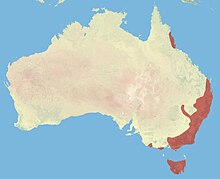Tiger quoll
| Tiger quoll | |
|---|---|
 |
|
| Scientific classification | |
| Kingdom: | Animalia |
| Phylum: | Chordata |
| Class: | Mammalia |
| Infraclass: | Marsupialia |
| Order: | Dasyuromorphia |
| Family: | Dasyuridae |
| Genus: | Dasyurus |
| Species: | D. maculatus |
| Binomial name | |
|
Dasyurus maculatus Kerr, 1792 |
|
| Subspecies | |
 |
|
| Range of the tiger quoll: | |
The tiger quoll (Dasyurus maculatus), also known as the spotted-tail quoll, the spotted quoll, the spotted-tailed dasyure or the tiger cat, is a carnivorous marsupial of the quoll genus Dasyurus native to Australia. With males and females weighing around 3.5 and 1.8 kg, respectively, it is mainland Australia's largest carnivorous marsupial, and the world's longest extant carnivorous marsupial (the biggest is the Tasmanian devil). Two subspecies are recognised; the nominate is found in wet forests of southeastern Australia and Tasmania, and a northern subspecies, D. m. gracilis, is found in a small area of northern Queensland and is endangered.
The tiger quoll is a member of the family Dasyuridae, which includes most carnivorous marsupial mammals. This quoll was first described in 1792 by Robert Kerr, the Scottish writer and naturalist, who placed it in the genus Didelphis, which includes several species of American opossum. The species name, maculatus, indicates this species is spotted.
Two subspecies are recognised:
The tiger quoll is the largest of the quolls. Males and females of D. m. maculatus weigh on average 3.5 and 1.8 kg, respectively, and males and females of D. m. gracilis weigh on average 1.60 and 1.15 kg, respectively. The next-largest species, the western quoll, weighs on average 1.31 kg for males and 0.89 kg for females. The tiger quoll has relatively short legs, but its tail is as long as its body and head combined. It has a thick head and neck and a slightly rounded and elongated snout. It has five toes on each foot, both front and hind, and the hind feet have well-developed halluces. Its long pink foot pads are ridged, an adaptation for its arboreal lifestyle. This makes up for the fact that its tail is not prehensile. The tiger quoll has a reddish-brown pelage with white spots, and colourations do not change seasonally. It is the only quoll species with spots on its tail in addition to its body. Its fur and skin are covered in orange-brown-coloured oil. The underside is typically grayish or creamy white. The average length of D. m. maculatus is 930 mm for males and 811 mm for females, respectively. For D. m. gracilis, the average length of males and females, respectively, is 801 and 742 mm.
...
Wikipedia

